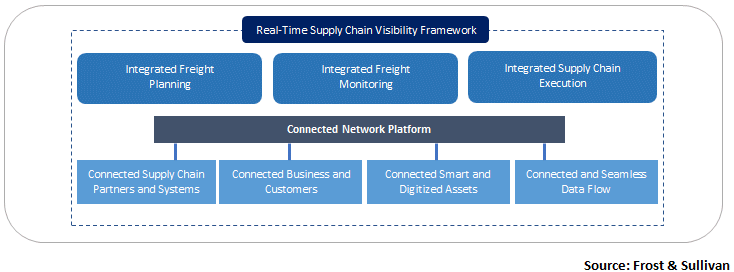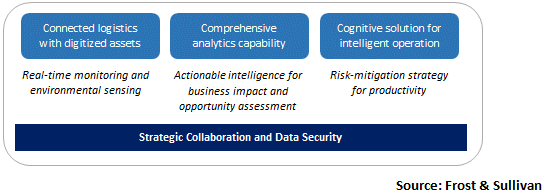The global logistics industry has evolved with rapid technological innovations with the emergence of digital technologies. Supply chain visibility has become the most sought-after service by shippers and as a capability for logistics service providers. The global pandemic crisis has unveiled the fragility of the global supply chain and the significance of end-to-end visibility. Across industries, with globalization, market complexities, and peer competition, it has become difficult for companies to have a close check on their expanding supply networks. A lengthy supply chain with more parties involved increases the supply chain complexity, resulting in process disruptions and uncertainties. Today, the big data revolution, digitization with new-age business models, and evolving customer expectations have disintegrated the traditional mindset of the linear supply chain approach for freight management; it is now an integrated approach with an open network framework for end-to-end, real-time supply chain visibility.
Freight visibility – A priority for shippers and logistics service providers
With economies slowly reopening from the effects of COVID-19, shippers and logistics service providers are prioritizing transparency to attain operational efficiency and to control costs as they have become more aware of the shift in customer expectations and carrying inventory cost. The new-age business models and digital solutions have provided customers with more choices than ever before, and they’ve become less tolerant of late deliveries. Late shipments due to operational bottlenecks have unexpected consequences and ripple effects on the supply chain and affect the entire value chain, from inventory to production and resource management. Many shippers and freight service providers prioritize minimizing their operational costs. However, the lack of supply chain visibility is the root cause of increased operational costs with significant process slowdowns. Freight visibility with data-powered tools helps shippers and logistics companies drive proactive management practices. Today, in the 24/7 digital world, it’s not just about having greater visibility for shippers; it has evolved to the need for real-time freight visibility to keep operations moving and on schedule.
Moving beyond track-and-trace solutions
The traditional linear supply chain model had a one-sided approach – facilitating the cargo owners to track shipments at their end. Freight visibility moved from being a nice-to-have factor to a mandatory business requirement for both shippers and logistics service providers. As soon as a shipment is scheduled with a carrier, stakeholders such as shippers, freight forwarders and end-customers prefer to have a single dashboard view for the shipments.
Exhibit 1: The Linear Supply Chain Paradigm
Today, the focus is no longer just on the shipment status by the supply chain milestone and estimated time of arrival (ETA) with track-and-trace functions, but to have access for more information such as the condition of cargo in transit and real-time location. Actionable insights on off-schedule shipments help shippers to make more informed decisions across the supply chain to have improved operational planning, procurement operations and performance benchmarking, enhanced customer experience, and risk-mitigation strategies.
Exhibit 2: Supply Chain Visibility Framework
Strategic Collaboration as a New Normal for Integrated Supply Chain Visibility
The communication process to attain supply chain visibility among stakeholders such as logistics service providers, shippers, and freight brokers has come a long way over the years. It has transformed from sequential and siloed operations that are discreet to using electronic data interchange and application program interface (API)-powered modular solutions. This improvised communication process has granted the required agility for changing business needs. Instead of a trend, real-time supply chain visibility for freight management has become a reality for shippers and logistics service providers by leveraging technologies such as big data analytics, cloud computing platforms, and artificial intelligence. As the demand for supply chain transparency increases from customers, it becomes the responsibility of logistics service providers to simplify operations by having a connected and digitized information flow. Today, many third-party solution providers are operating in the SaaS (software-as-a-solution) space, offering supply chain visibility solutions, and they have become easily accessible for even small and medium-sized logistics service providers that have IT budget constraints. Some shippers and logistics service providers leverage the Internet of Things (IoT) to digitize their assets and have end-to-end visibility and condition monitoring capabilities for enhanced freight management. The integration of stakeholder systems across the supply chain network allows a seamless flow of freight information, and data sharing in a connected ecosystem makes the system interoperable.
Exhibit 3: Connected Freight Management
With more supply chain visibility solution providers in the market leveraging different digital technologies, the connectivity, reliability, and scalability of solutions offered are questioned. It is critical for shippers and logistics service providers to reap the benefits of real-time insight on freight visibility, as choosing a wrong vendor with the wrong technology can hurt the operational efficiency and the company’s bottom line. It is important to have a stringent assessment process for the visibility of solution providers on factors such as a platform’s framework for scalability, integration speed, method of data connectivity, analytics capability, and data security.
Exhibit 4: Requirements for Choosing a Real-time Visibility Solution Provider
Conclusion
Shippers and logistics service providers for connected freight management rely heavily on the capacities of their value chain partners and software solution providers for optimized supply chain operations. In the post-pandemic situation, shippers and logistics companies will be categorized into those who are taking a high-risk gamble by not working on their supply networks and those who make investments to have a resilient model with real-time supply chain visibility. In a platform-enabled digitized ecosystem, to attain a distinct competitive advantage and significant strategic gains, it is essential for shippers and logistics service providers to work closely with supply chain visibility solution providers to create a real process convergence for connected freight management. Moving forward, supply chain visibility, by default, would be the first thing for shippers and logistics service providers to gain access to for actionable information, helping companies rethink their critical success factors and create a “new normal” standard of efficiency and performance metrics across their supply chain and logistics processes.
Should you have any queries on the impact of COVID-19 across industries, need more information on this or any related topic, or would like to schedule an interview/interaction with our spokesperson, please email Priya George at priyag@frost.com.







